Unless you live by the beach or in a lake house, chances are transportation is the main issue when you want to go out kayaking. Traveling with a bulky kayak can be extenuating, unless you have an inflatable one, but even these kayaks come with their challenges.
Choosing the best kayak bike trailer will give you the freedom to take it easy and move your kayak around without too much hassle. Such things are light, adjustable, and can be put together with no experience whatsoever. Now, what do you need to know about these trailers before purchasing one?
Top 5 Bike Kayak Trailers
Here are some of the best rated kayak bike trailers on the market.
1. Rambo Bikes Canoe and Kayak Trailer Cart

Best for Everyday Use
- Rambo’s kayak bike trailer is built with heavy duty uses in mind. Not only will it last for a lifetime, but you can use it on a daily basis with no issues at all. It can be adjusted and fits kayaks of more sizes, with a maximum capacity of 300 pounds, yet you shouldn’t exceed 70 or 80 pounds on a bicycle.
- Overall, it only weighs 33 pounds, so it’s not that difficult to carry it around. It also has padded contact points to avoid scratching or damaging your kayak. It’s made of steel and features a heavy duty construction.
- The package also includes a few straps for extra security.
Pros
- Highly portable
- Good capacity
- Great adjustability
- Made to last for ages
Cons
- Designed for Rambo bikes, so it may need adjustments and customization for other bikes
2. GanFindX Heavy-Duty Universal Kayak Cart
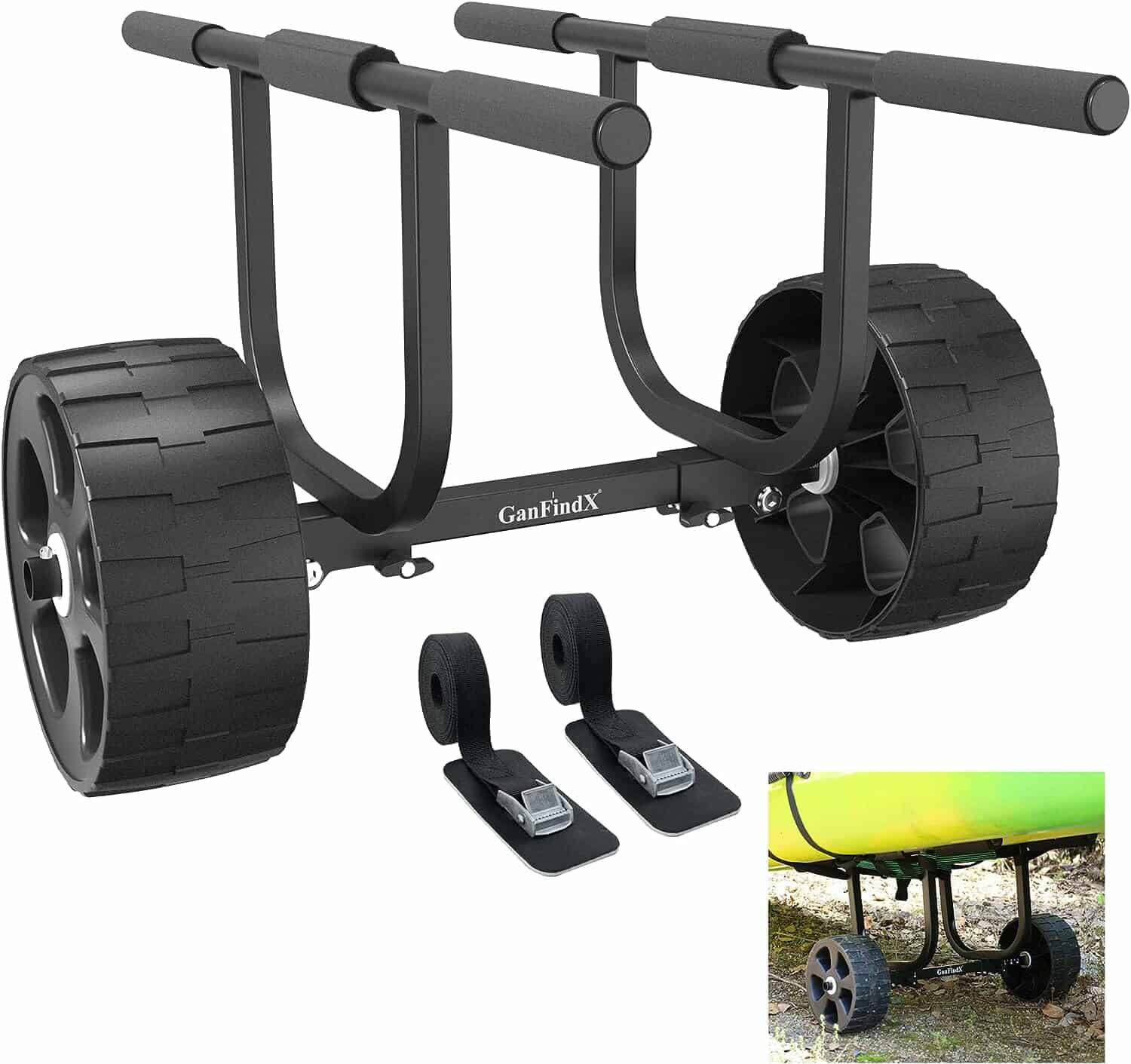
Best for Light Use
- This is one of the cheapest and most cost-effective kayak bike trailers out there, mainly because it’s designed like a cart rather than a trailer. To attach it to a bike, you’ll need to improvise whether you attach the kayak to the bike or a long metallic bar to the cart.
- It’s made of durable aluminum and weighs less than four pounds. It has two wheels based on rigid rubber, meaning you don’t have to worry about punctures or deflated tires. It can be assembled in less than a minute and given its compact size, chances are you won’t have to disassemble it for storage.
- It has a gasket to protect against knocks, as well as a fluid structure to allow water to come out.
Pros
- Highly portable
- Good value for money
- Easy to assemble and disassemble
- Durable wheels
Cons
- May need some improvisation to be attached to a bike
3. Wike Ultra-Lite Aluminum Boat Cart for Canoe
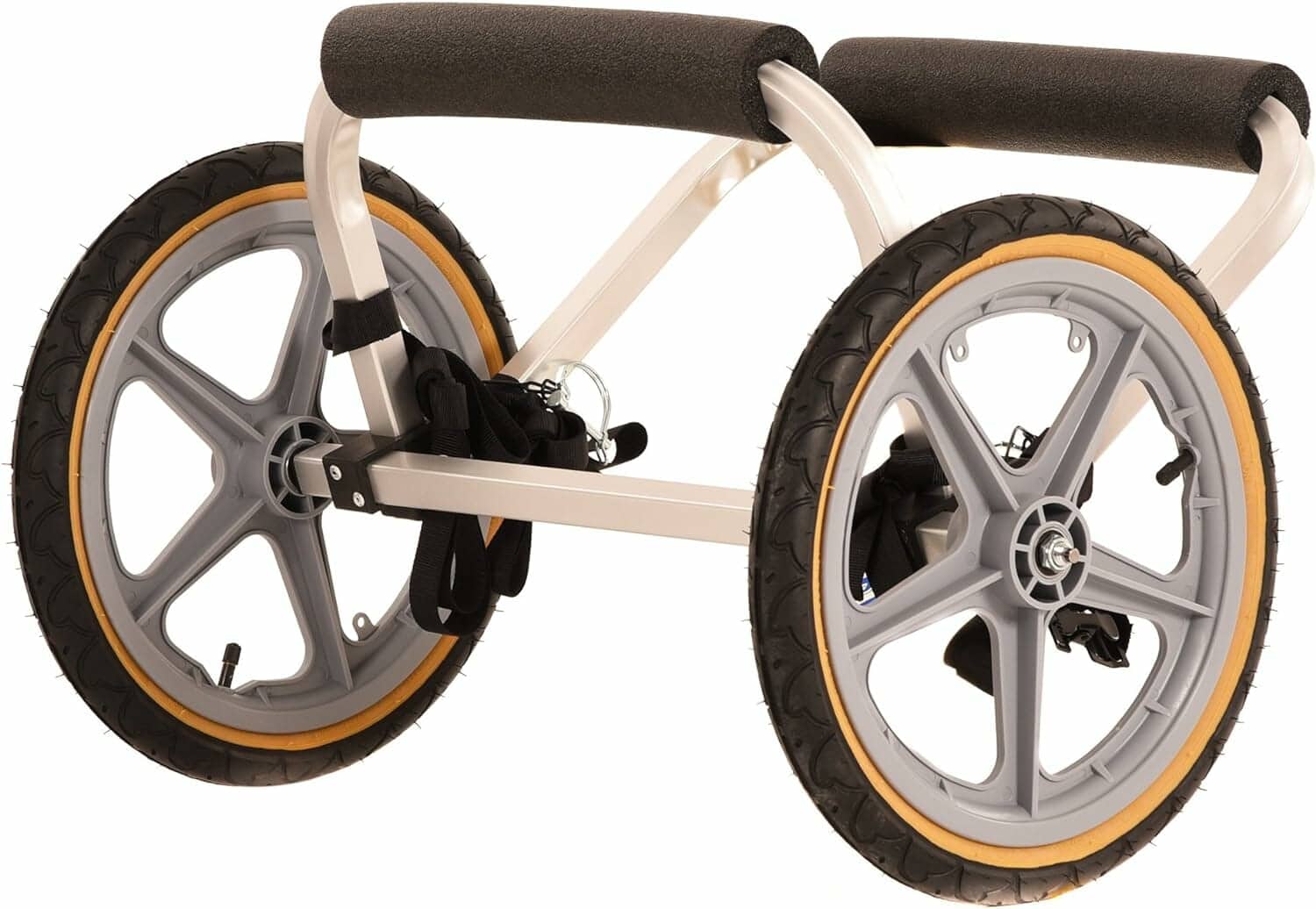
Best for all Types of Kayaks
- This cart trailer is made of aluminum, meaning there’s not too much strain when carrying it by bike. It ensures you’ll be able to maneuver your bike without too much effort, with the kayak smoothly going behind. It’s foldable and easy to store.
- Its capacity goes up to 70 pounds, more than enough for a kayak. It has a hitch feature that guarantees for the kayak to stay behind the wheel, rather than come too close. Aluminum wheels can also be removed when not in use.
- The trailer will always stay on track, even during bends. It has an adjustable width to ensure it’s always well balanced and stable.
Pros
- Ideal for kayaks, canoes, paddleboards, and other types of boats
- Versatile uses
- Easy to put together
- Adjustable width
Cons
- Not the best choice for very heavy boats
4. Railblaza Genuine C-Tug Kayak Cart
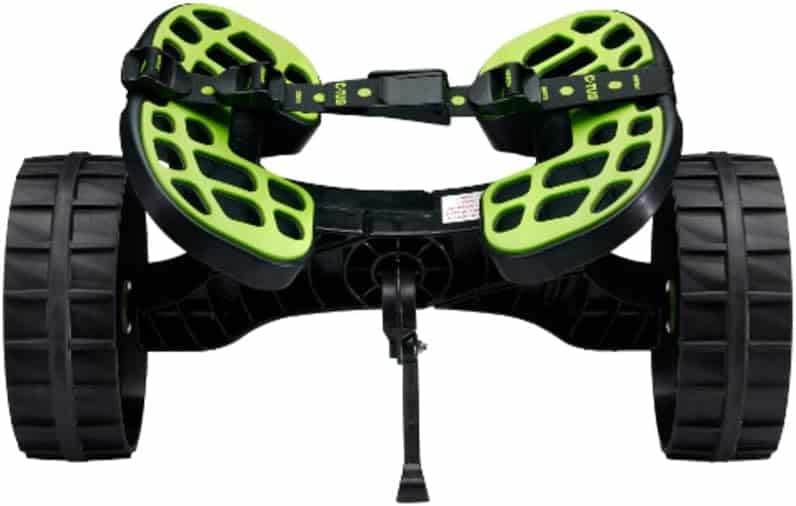
Most Secure
- Railblaza has designed one of the most protective trailers for kayaks out there. It has a simplistic design, but small details make the difference. It can be assembled with no tools at all and features reinforced composite materials with hull pads for protection.
- Wheels are made of solid rubber, so they’ll never deflate. The axle also comes with a kickstand, ideal for uneven terrains. Simply put, you can take this kayak anywhere. Talking about a solid build, it’s also based on stainless steel for rust protection.
- Kayaks can be easily and safely secured on this cart, meaning there are no risks when traveling with it behind your bike.
Pros
- Durable design
- Safe for kayaks
- Innovative features
- Adjustable kickstand
Cons
- Moving kayak on sand could be tricky because opening in the wheels will let sand in
5. Canalhout Lightweight 304 Stainless Steel Kayak Carrier
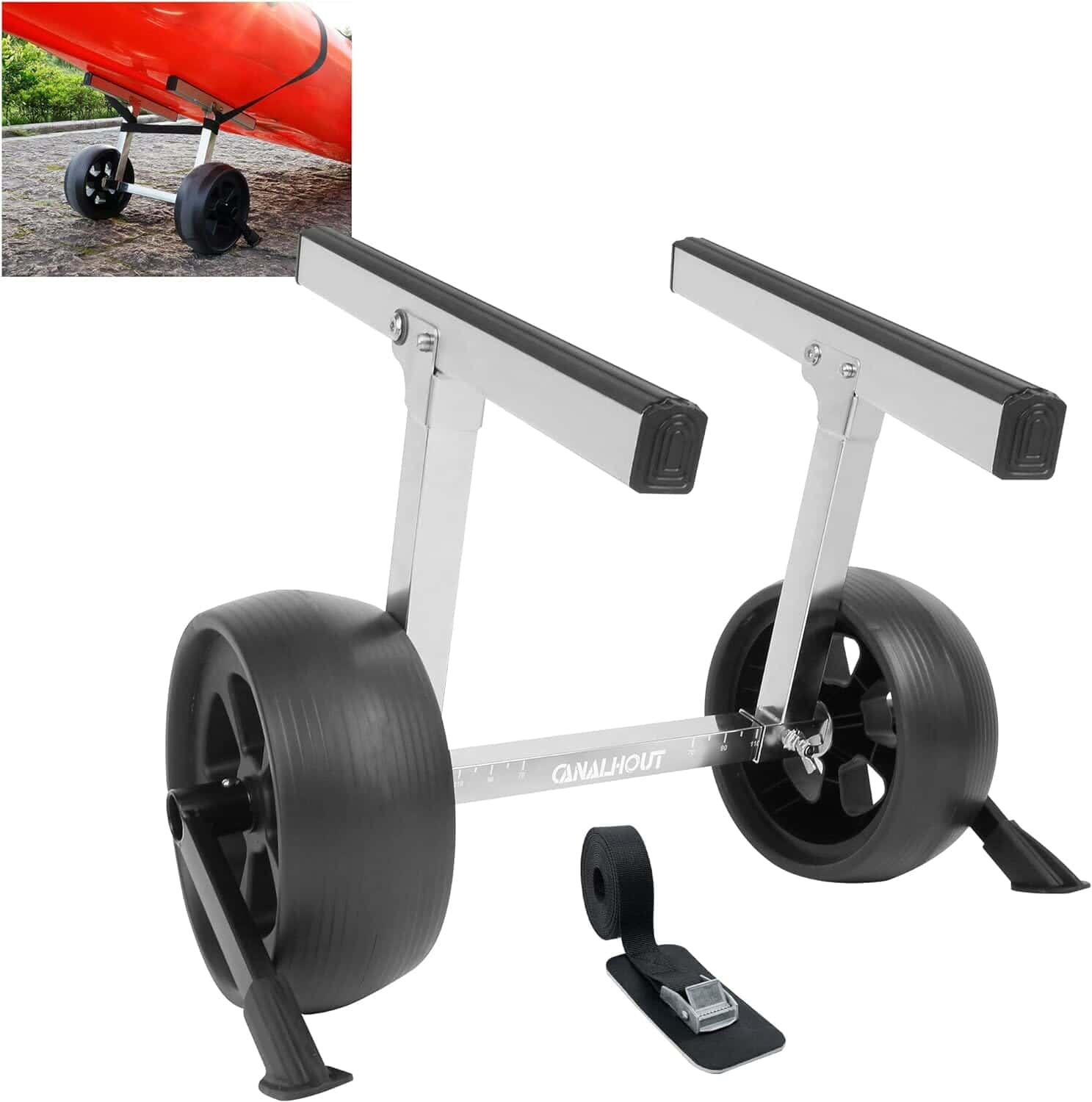
Best for Weight Capacity
- Canalhout may have designed the best kayak bike trailer if you want something simple, sturdy, and with a great weight capacity. It’s based on 304 stainless steel, which is super sturdy and solid. It has an impressive weight rating of 220 pounds, so it makes no difference how heavy your boat is.
- The unit comes with soft rubber for contact points to ensure your kayak won’t slip away or get damaged. Moreover, there’s an adjustable strap to ensure maximum security. Width can be adjusted for extra stability, too, not to mention being able to put the kayak trailer together in about a minute.
- It’s a simple and straightforward unit that will make loading the kayak a breeze, too, with no effort whatsoever.
Pros
- Impressive weight capacity
- Adjustable
- Soft rubber contact points
- Can be used to move other things, too
Cons
- Wheels make it difficult to transport the kayak on sand
Are kayak bike trailers worth it?
Based on where you live, the answer is pretty obvious. How else are you going to transport your kayak? People choose convenience and go by car, whether their kayaks go on a rack at the top or on a trailer at the back.
But over the past years, kayak trailers for bikes have become more and more popular. That’s your opportunity to enjoy two different outdoor activities at once. Paddle, rest on a kayak for a few hours, and paddle some more coming back home. What can be better than that?
Kayak bike trailers are similar to vehicle trailers, but they’re lighter. At the same time, they’re usually suitable for one kayak, yet you can find models with storage for two as well. They’re adjustable, and they also allow transporting inflatable kayaks while inflated, so they’re very convenient.
What factors to consider when choosing kayak bike trailers
There are quite a few considerations to keep in mind when hunting the best kayak bike trailer. Choosing the wrong one may put too much strain on the bike, making transportation a nightmare.
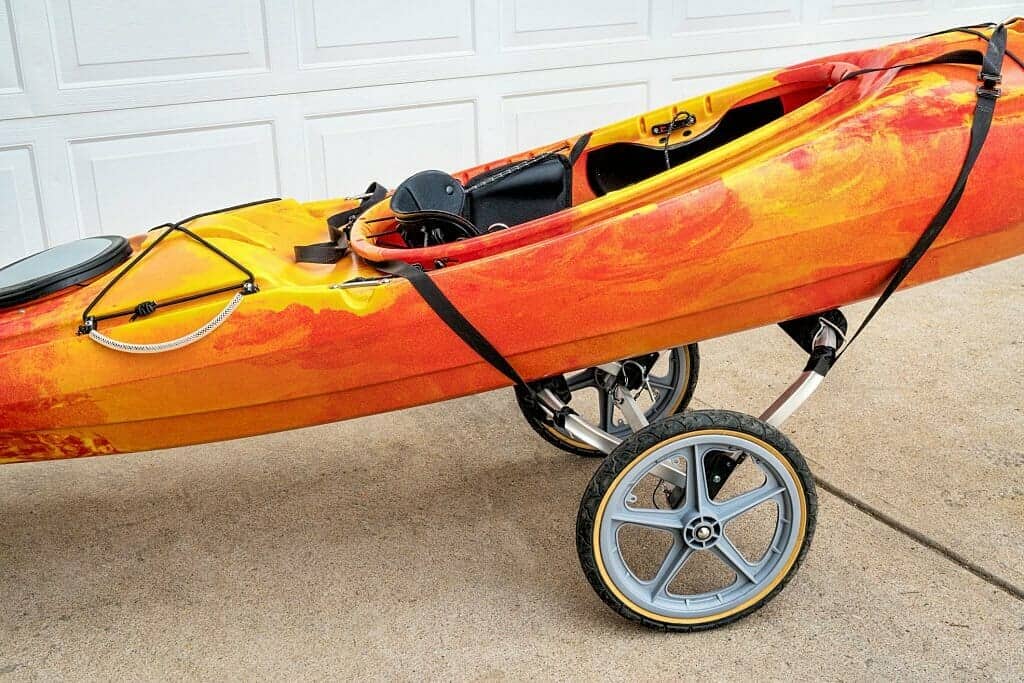
Capacity
The load capacity is critical. Most bike trailers can take one kayak, and some of them can take two. Some of them go further than that, but cycling could be difficult. If you have a motorbike, it should be no problem at all.
Some kayak bike trailers can be adjusted based on what you want to transport. They’re more versatile but also more expensive.
Material
Aluminum is usually the main material, as well as a top recommendation for kayak trailers. It’s lightweight and strong, but it also features good resistance to corrosion. After all, if you go kayaking in saltwater, some of it will naturally go on the trailer, too.
Aluminum is also lighter than steel, so cycling will be much easier. Plus, steel can corrode in the long run.
Wheel size
No one really pays attention to the wheel size, despite being an important consideration. Massive wheels will make it difficult to cycle, while small wheels may reduce the stability of the trailer. Inflatable tires make a better choice for bikes. Go for a middle range set.
Wide wheels will also help with stability, especially on uneven terrains. They can also absorb shocks, so towing the kayak is much smoother.
Based on the terrain, you can inflate tires at different levels of pressure.
Stability
Talking about stability, it also depends on the size of your kayak. Make sure wheels are wide, as well as the actual trailer. A sturdy construction will also add to the stability. If you can, distribute the weight across the whole trailer.
Ease of use
It’s essential to get a kayak bike trailer that makes it simple to load and unload kayaks. From this point of view, a quick release mechanism will help, but you also need some adjustable racks and straps for extra security. Some kayak trailers are also foldable for easy storage.
Available budget
Last, but not least, it makes sense to avoid overspending. Kayak trailers come in more sizes and price ranges. Look for something that offers what you need without spending a fortune on random bells and whistles. A few reviews will also help you make an informed decision.
How to Use a Kayak Bike Cart
So, you got yourself a kayak bike cart? Awesome choice! Let me walk you through how to use it with a super helpful video. Trust me, once you get the hang of it, you’ll wonder how you ever managed without one.
How to make your own DIY kayak bike trailer
Making your own kayak bike trailer is not the most difficult job in the world if you use your creativity and imagination. There are plenty of ideas out there, whether you want it to look more like a cart or an actual trailer.
A simple look at a classic trailer, a couple of wheels, and some pieces of wood are usually more than enough to design your own trailer. Indeed, you can take it further and use metallic components for the frame, too, but that implies being able to weld things.
You can find wheels that can be attached underneath a structure in most hardware stores, mainly used for carts or gates. You can then create a structure based on solid and treated wood. Get some screws, a drill, and you’re ready to go.
The easiest concept implies getting a thick wooden board that’s longer than your kayak’s width for stability. Attach two wheels on each side. Design a V shaped structure with this board used as a base, to give it a triangle design. Attach a hook at the tip of the V, too.
Get some more wooden pieces for support to make sure the kayak doesn’t move. You can also nail in some pieces of rubber for protection. Paint it if you want, and you’re ready to go.
Working with wood gives you plenty of room for adjustments and design changes. You can replicate pretty much any type of kayak bike trailer design you see in stores, but give it a unique customization.
FAQs
Still unsure about the optimal kayak bike trailer?
- Are bicycle trailers legal?
Normally, if you can cycle, you can almost always have a bike trailer as well. You couldn’t even have a massive one because it would be difficult to carry, especially when loaded. Even kids are allowed to ride with trailers in most places, as long as they’re physically able to pull them.
- How much weight can a kayak bike trailer take?
Many kayak bike trailers can easily take 70 pounds, even up to 100 pounds. That’s more than enough for most kayaks and canoes. Some higher end units can take over 200 pounds, but that’s too much if you have to cycle. Even an electric bike may struggle with this kind of weight.
- How much does a kayak bike trailer cost?
Like for everything else in life, different brands have different quality standards, meaning prices are just as varied. You can expect to pay around $50 to $75 for a cart design and $150 to $300 for a large trailer design. If you choose to do it yourself, you’ll probably pay half of the price.
Bottom line
There are no doubts about it, kayak trailers for bikes are incredibly useful. Not only do they provide more portability if you don’t drive, but they’ll also allow you to combine two excellent activities for outdoor enthusiasts.
Choosing the best kayak bike trailer can be a bit tricky, though. There are lots of options, so make sure you know what you’re looking after. Don’t fall for random bells and whistles.
The concept is gaining more and more popularity these days, so you’ll also be able to find numerous guides for DIY projects.
At the end of the day, if it’s stable on wheels and features straps for you to secure your boat, there’s nothing to worry about.

